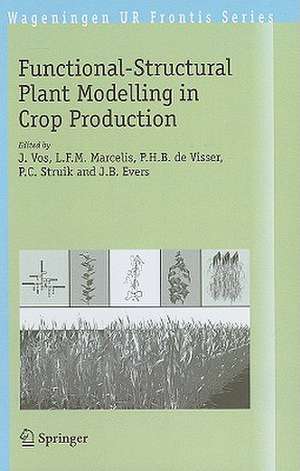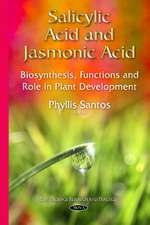Functional-Structural Plant Modelling in Crop Production: Wageningen UR Frontis Series, cartea 22
Editat de J. Vos, L.F.M. Marcelis, P.H.B Visser, Paul C. Struik, J.B. Eversen Limba Engleză Hardback – 30 mar 2007
This book describes the philosophy of functional-structural plant modelling and several tools for making FSPMs; it outlines methods for measuring essential parameters, including those pertaining to plant structure. As FSPMs offer new opportunities to model sink–source interactions, the physiological theory and modelling approaches regarding partitioning of carbon are given specific attention. Examples of application of FSPMs include wheat modelling in the context of remote sensing and the analysis of predator–prey insect interactions on glasshouse plants.
The book will be useful for scientists and advanced students interested in innovative approaches in plant and crop modelling.
| Toate formatele și edițiile | Preț | Express |
|---|---|---|
| Paperback (1) | 1218.83 lei 6-8 săpt. | |
| SPRINGER NETHERLANDS – 30 mar 2007 | 1218.83 lei 6-8 săpt. | |
| Hardback (1) | 1224.36 lei 6-8 săpt. | |
| SPRINGER NETHERLANDS – 30 mar 2007 | 1224.36 lei 6-8 săpt. |
Din seria Wageningen UR Frontis Series
- 15%
 Preț: 633.35 lei
Preț: 633.35 lei - 18%
 Preț: 940.72 lei
Preț: 940.72 lei - 18%
 Preț: 947.04 lei
Preț: 947.04 lei - 18%
 Preț: 1230.35 lei
Preț: 1230.35 lei - 18%
 Preț: 948.16 lei
Preț: 948.16 lei - 24%
 Preț: 1042.98 lei
Preț: 1042.98 lei - 18%
 Preț: 942.44 lei
Preț: 942.44 lei - 24%
 Preț: 1028.84 lei
Preț: 1028.84 lei - 24%
 Preț: 787.50 lei
Preț: 787.50 lei - 18%
 Preț: 946.55 lei
Preț: 946.55 lei - 24%
 Preț: 1035.78 lei
Preț: 1035.78 lei - 18%
 Preț: 944.06 lei
Preț: 944.06 lei - 18%
 Preț: 1213.34 lei
Preț: 1213.34 lei - 24%
 Preț: 1045.93 lei
Preț: 1045.93 lei - 18%
 Preț: 1218.83 lei
Preț: 1218.83 lei - 18%
 Preț: 1218.06 lei
Preț: 1218.06 lei - 18%
 Preț: 941.38 lei
Preț: 941.38 lei - 18%
 Preț: 938.66 lei
Preț: 938.66 lei - 15%
 Preț: 639.08 lei
Preț: 639.08 lei - 18%
 Preț: 941.68 lei
Preț: 941.68 lei - 24%
 Preț: 791.79 lei
Preț: 791.79 lei - 15%
 Preț: 639.59 lei
Preț: 639.59 lei -
 Preț: 380.63 lei
Preț: 380.63 lei - 15%
 Preț: 629.56 lei
Preț: 629.56 lei
Preț: 1224.36 lei
Preț vechi: 1493.13 lei
-18% Nou
Puncte Express: 1837
Preț estimativ în valută:
234.31€ • 254.43$ • 196.82£
234.31€ • 254.43$ • 196.82£
Carte tipărită la comandă
Livrare economică 22 aprilie-06 mai
Preluare comenzi: 021 569.72.76
Specificații
ISBN-13: 9781402060328
ISBN-10: 1402060327
Pagini: 280
Ilustrații: X, 272 p.
Dimensiuni: 155 x 235 x 21 mm
Greutate: 0.64 kg
Ediția:2007
Editura: SPRINGER NETHERLANDS
Colecția Springer
Seria Wageningen UR Frontis Series
Locul publicării:Dordrecht, Netherlands
ISBN-10: 1402060327
Pagini: 280
Ilustrații: X, 272 p.
Dimensiuni: 155 x 235 x 21 mm
Greutate: 0.64 kg
Ediția:2007
Editura: SPRINGER NETHERLANDS
Colecția Springer
Seria Wageningen UR Frontis Series
Locul publicării:Dordrecht, Netherlands
Public țintă
ResearchCuprins
Functional-Structural Plant Modelling in Crop Production.- Measurements for Functional-Structural Crop Models.- The L+C Plant-Modelling Language.- Groimp as a Platform for Functional-Structural Modelling of Plants.- The Virtual Crop-Modelling System ‘VICA’ Specified for Barley.- A Mathematical Approach Estimating Source and Sink Functioning of Competing Organs.- Modelling the Light Environment of Virtual Crop Canopies.- Photosynthesis And Carbon Balance.- Concepts of Modelling Carbon Allocation Among Plant Organs.- Mechanistic Modelling of Carbon Partitioning.- Numerical Methods for Transport-Resistance Source–Sink Allocation Models.- L-Peach, an L-System-Based Model for Simulating Architecture, Carbohydrate Source–Sink Interactions and Physiological Responses of Growing Trees.- Canonical Modelling.- GRAAL: Growth, Architecture, Allocation.- Functional-Structural Modelling of Gramineae.- Functional-Structural Modelling of Faba Bean.- Functional-Structural Modelling of Chrysanthemum.- Towards Functional-Structural Modelling of Greenhouse Cucumber.- 3D Canopy Modelling as a Tool in Remote-Sensing Research.- Functional-Structural Modelling as a Potential Tool to Assess the Impact of Resource Competition on Arable Communities.- A Grammar-Based Model of Barley Including Virtual Breeding, Genetic Control and a Hormonal Metabolic Network.- Modelling Plant Canopies for Biocontrol and Biodiversity.
Textul de pe ultima copertă
Functional-structural plant models (FSPMs) describe in quantitative terms the development over time of the three-dimensional (3D) structure of plants as governed by physiological processes and affected by environmental factors. FSPMs are particularly suited to analyse problems in which the spatial structure of the plant or its canopy is an essential factor to explain, e.g., plant competition (intra-plant, inter-plant, inter-species) and the effects of plant configuration and plant manipulation (e.g., pruning and harvesting) on yield and produce quality.
This book describes the philosophy of functional-structural plant modelling and several tools for making FSPMs; it outlines methods for measuring essential parameters, including those pertaining to plant structure. As FSPMs offer new opportunities to model sink–source interactions, the physiological theory and modelling approaches regarding partitioning of carbon are given specific attention. Examples of application of FSPMs include wheat modelling in the context of remote sensing and the analysis of predator–prey insect interactions on glasshouse plants.
The book will be useful for scientists and advanced students interested in innovative approaches in plant and crop modelling.
This book describes the philosophy of functional-structural plant modelling and several tools for making FSPMs; it outlines methods for measuring essential parameters, including those pertaining to plant structure. As FSPMs offer new opportunities to model sink–source interactions, the physiological theory and modelling approaches regarding partitioning of carbon are given specific attention. Examples of application of FSPMs include wheat modelling in the context of remote sensing and the analysis of predator–prey insect interactions on glasshouse plants.
The book will be useful for scientists and advanced students interested in innovative approaches in plant and crop modelling.
Caracteristici
Discusses methodology to program architecture of plant models (e.g. L-systems) Provides update of the objectives and approaches of combining architecture and functional plant/crop modelling Emphasis is placed on the physiological knowledge of sink-source interactions






